Introduction to Herp Highlights Episode Timber Rattlesnake Kinship Analysis
Welcome to the latest episode of Herp Highlights Episode Timber Rattlesnake Kinship Analysis
, where we dive deep into the fascinating world of reptiles. This time, we’re turning our attention to a remarkable creature—the timber rattlesnake. Known for its distinctive markings and important role in local ecosystems, this snake is more than just a captivating sight in the wild.
In our Herp Highlights Episode Timber Rattlesnake Kinship Analysis
, we’ll explore how these snakes are connected at a genetic level and what that means for their populations across North America. Studying kinship helps us unravel the mysteries of their behavior, habitat use, and survival strategies. Are you ready to join us on this enlightening journey? Let’s slither into some intriguing insights about one of nature’s most misunderstood creatures!
Read More: New Lanternfly Species Vietnam Cambodia
The Importance of Studying Kinship in Reptiles
Understanding kinship in reptiles opens a window into their behavior and ecology. These relationships are crucial for species survival, influencing mating patterns and social structures.
Studying kinship helps scientists track genetic diversity within populations. This information is vital for conservation efforts, as it can highlight areas needing protection or restoration.
Reptiles often exhibit complex family dynamics that affect their reproductive success. By analyzing these connections, researchers can gain insights into how environmental changes impact breeding strategies.
Furthermore, knowledge of kinship enhances our comprehension of disease transmission among groups. Identifying related individuals may reveal vulnerabilities to pathogens, guiding health management in wild populations.
Delving into reptile kinship enriches our understanding of biodiversity and ecosystem functioning while fostering informed conservation practices.
Methods Used for Kinship Analysis
The methods used for kinship analysis in the Timber Rattlesnake study are diverse and innovative. Researchers often rely on genetic sequencing to unravel family connections among these reptiles. By analyzing mitochondrial DNA, they can trace maternal lineages effectively.
Additionally, microsatellite markers play a crucial role. These short, repeating sequences of DNA help identify variations between individuals. They provide insights into population structure and relatedness.
Field studies complement lab work. Observing behaviors such as mating rituals helps researchers understand social dynamics within timber rattlesnake populations. Combining genetic data with behavioral observations offers a comprehensive view of kinship ties.
Technology also enhances research efforts. Advanced software tools enable scientists to visualize relationships through intricate family trees based on genetic information. This multidimensional approach is essential for accurately assessing how closely related individuals are within their ecosystems.
Findings of the Study
The study revealed intricate kinship patterns among timber rattlesnakes. Researchers discovered surprising genetic similarities across diverse populations. This suggests a broader gene flow than previously understood.
Interestingly, some snakes were found to be more closely related than their geographic proximity would indicate. This challenges existing assumptions about the isolation of certain groups.
Moreover, the analysis indicated that environmental factors played a significant role in shaping these relationships. Habitat fragmentation appears to influence genetic diversity and kinship dynamics.
Data collected from various sites painted a complex picture of social structures within snake communities. The findings emphasize the adaptability and resilience of timber rattlesnakes amidst changing environments.
These insights contribute crucial knowledge to herpetological research, revealing how interconnectedness can impact species survival strategies in contemporary ecosystems.
Implications for Conservation Efforts
The findings from the Timber Rattlesnake kinship analysis carry significant implications for conservation efforts. Understanding genetic relationships among populations helps identify critical habitats and areas needing protection.
By uncovering which groups are closely related, conservationists can prioritize regions that serve as vital corridors for gene flow, ensuring healthy breeding patterns.
This knowledge also enables more effective management strategies tailored to specific populations rather than applying a one-size-fits-all approach. It highlights the importance of maintaining genetic diversity, essential for resilience against diseases and environmental changes.
Additionally, education plays a key role in fostering community awareness about these snakes’ ecological importance. Engaging local communities in conservation initiatives creates stewardship opportunities and promotes coexistence with this often-misunderstood species.
Incorporating kinship data into policy-making will empower wildlife managers to make informed decisions that benefit not only rattlesnakes but entire ecosystems they inhabit.
Future Directions and Additional Research Opportunities
Future research on the Timber Rattlesnake kinship analysis opens exciting avenues. Genetic studies could delve deeper into population structure across various habitats. Understanding localized adaptations can further inform conservation strategies.
Exploring behavioral traits in relation to kinship may reveal how social structures influence survival rates. Observational field studies combined with genetic data will enrich our insights.
Additionally, there’s potential for collaboration with local universities and wildlife agencies. Engaging citizen scientists in monitoring efforts could expand data collection while fostering community interest.
Studying the effects of habitat fragmentation on kin relationships presents another critical area for exploration. How do these changes impact mating patterns and gene flow?
Such inquiries not only enhance scientific knowledge but also contribute meaningfully to preserving this iconic species’ future in our ecosystems.
Conclusion
The Herp Highlights Episode Timber Rattlesnake Kinship Analysis sheds light on a fascinating aspect of reptile biology. Understanding the intricate family ties among these snakes not only enriches our knowledge but also highlights their ecological importance.
Studying kinship can reveal patterns that inform conservation strategies, ensuring these species thrive in their natural habitats. The innovative methods used offer a template for future research, paving the way for deeper insights into other reptiles.
As we continue to explore these complex relationships, opportunities arise to enhance our efforts in wildlife preservation. Each finding contributes to our collective understanding of biodiversity and ecosystem health.
This ongoing journey emphasizes the significance of every species and reinforces why studying them matters now more than ever. The relationship between timber rattlesnakes provides valuable lessons not just about snakes themselves but about the interconnectedness of life on earth.













Leave a Reply